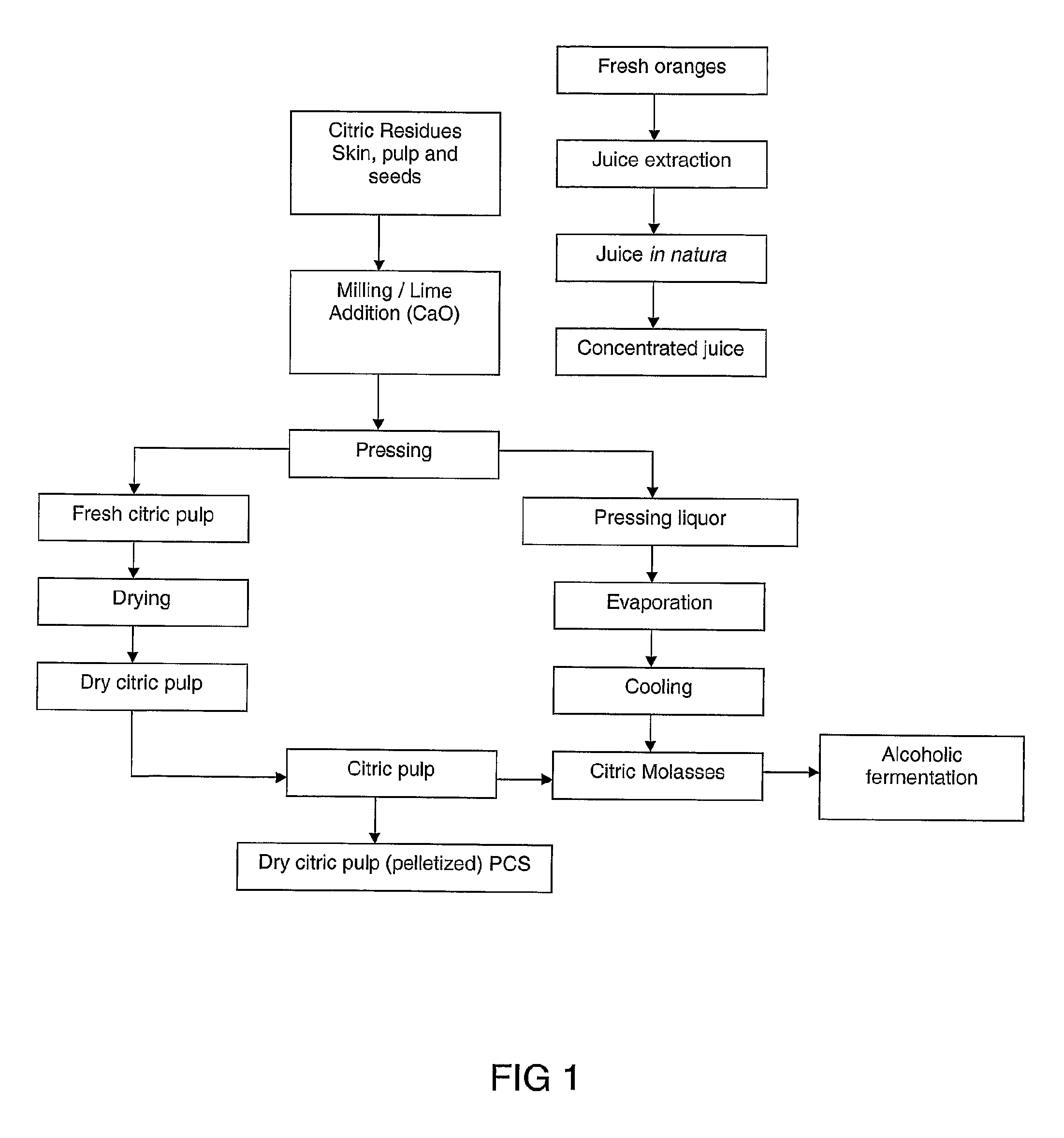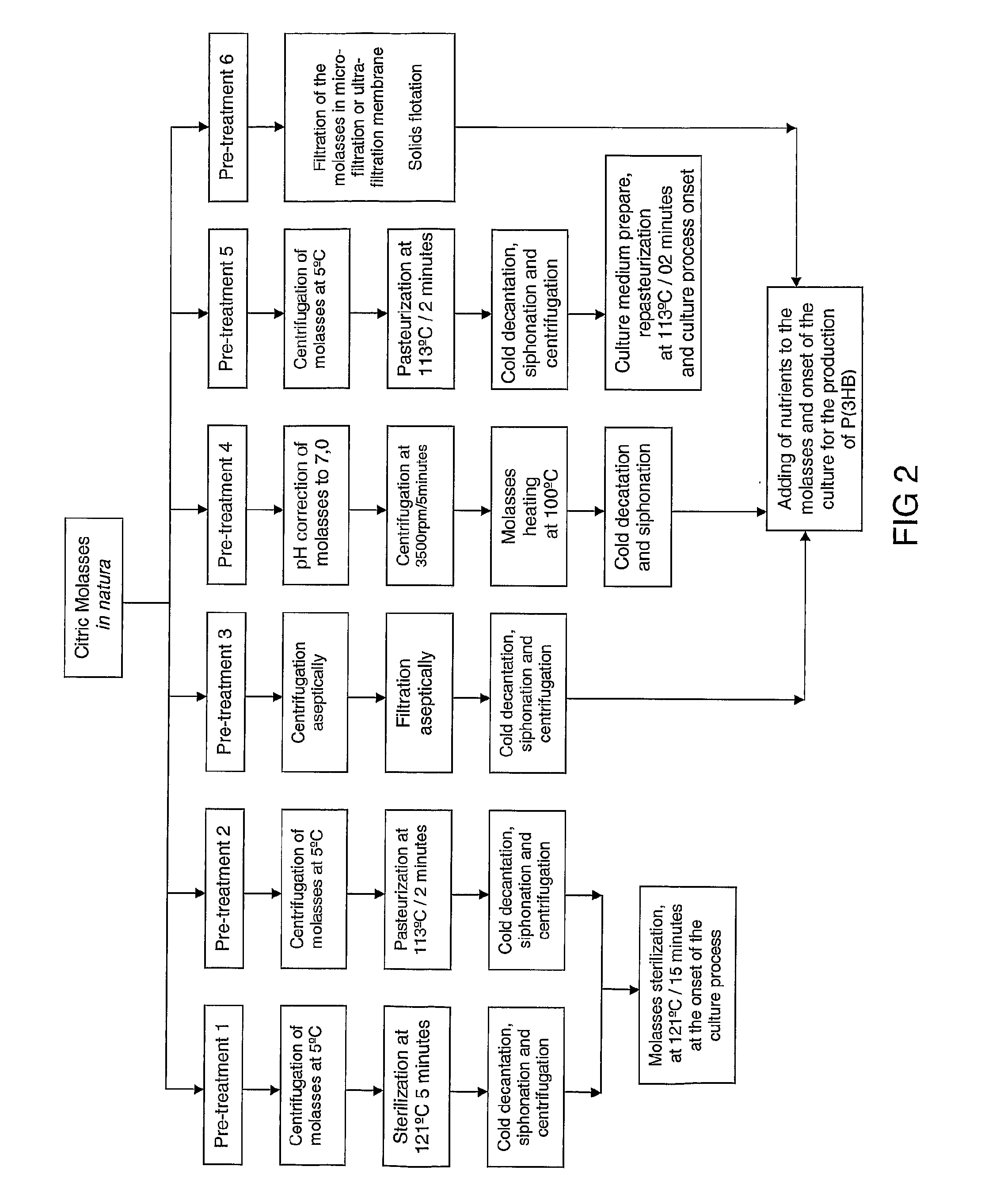Preparation of PHA (polyhydroxyalkanoates) from a citric residue
a technology of citric residues and polyhydroxyalkanoates, which is applied in the direction of dyeing process, fermentation, textiles and papermaking, etc., can solve the problems of serious environmental impact of plastics, damage to the decomposition process of organic matter, and jeopardizing the reproductive cycle of animals and crustaceans, so as to simplify the pre-treatment of raw materials and increase the added value
- Summary
- Abstract
- Description
- Claims
- Application Information
AI Technical Summary
Benefits of technology
Problems solved by technology
Method used
Image
Examples
example i
[0063]The first pre-inoculum was cultured in a Nutrient Broth kept in a rotator shaker for 24 hours. After this time, a volume equivalent to 10% of the final volume to be used in the culture process was transferred from the first to the second pre-inoculum, which is constituted of a mineral salts medium and nutrients adequate for the cellular growth of the microorganism used. This second pre-inoculum was kept in a rotator shaker, at 30° C. and 150 rpm for 54 hours. After this time, a volume equivalent to 10% of the final volume to be used in the culture process was transferred from the second pre-inoculum for the 5-liter reactor containing the medium composed by pressing liquor and / or citric molasses. The pressing liquor and / or citric molasses contains around 60 to 80 g·L−1 of ART (total reductor sugars), due to this reason, it must be diluted in a distilled water for the obtainment of a concentration of reductor sugars between 10-60 g.L−1 (growth limit for the C. necator), added wi...
example ii
[0064]The usage of pressing liquor of the orange bagasse was tested for the production of P(3HB) as a sub-product of the orange juice industry, without the application of a thermal treatment. The first pre-inoculum was cultured in a nutrient broth, kept in a rotator shaker at 30° C. and 150 rpm for 24 hours. After its activation, an equivalent volume at 10% of the final volume to be used in the culture process was transferred from the first to the second pre-inoculum, which is constituted of mineral salt medium and nutrients adequate for the cellular growth of the microorganism used. This second pre-inoculum was kept in a rotator shaker, at 30° C. and 150 rpm for 24 hours. After this time, a volume equivalent to 10% of the final volume to be used in the culture process was transferred from the second pre-inoculum to the 5-liter reactor containing pressing liquor presenting about 10 and 60 g·L−1 of reductor sugars. This medium was further added mineral salts and nutrients for the gro...
example iii
[0066]The Nutrient Broth was used as a first pre-inoculum performed in a rotator shaker at 30° C. and 150 rpm for 24 hours. The volume equivalent to 10% of the final volume to be used in the culture process was transferred from the first to the second pre-inoculum which is constituted of mineral salts medium and nutrients adequate for the cellular growth of the microorganism used. This second pre-inoculum was kept in a rotator shaker, at 30° C. and 150 rpm for 24 hours. After this time, the cells were transferred to the 5-liter reactor containing the pressing liquor and / or citric molasses (about 60 to 80 g·L−1 of ART) diluted in distilled water for the obtainment of a concentration of reductor sugars between 10-60 g·L−1 and added with mineral salts and nutrients for the growth. The temperature of 35° C. was applied. The pH was kept in 7.0 and the agitation ranged from 400-900 rpm, the oxygen concentration remained superior to 20% of the saturation with atmospheric air for 26 hours o...
PUM
| Property | Measurement | Unit |
|---|---|---|
| temperature | aaaaa | aaaaa |
| concentration | aaaaa | aaaaa |
| concentration | aaaaa | aaaaa |
Abstract
Description
Claims
Application Information
 Login to View More
Login to View More - R&D
- Intellectual Property
- Life Sciences
- Materials
- Tech Scout
- Unparalleled Data Quality
- Higher Quality Content
- 60% Fewer Hallucinations
Browse by: Latest US Patents, China's latest patents, Technical Efficacy Thesaurus, Application Domain, Technology Topic, Popular Technical Reports.
© 2025 PatSnap. All rights reserved.Legal|Privacy policy|Modern Slavery Act Transparency Statement|Sitemap|About US| Contact US: help@patsnap.com



